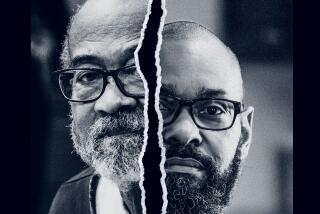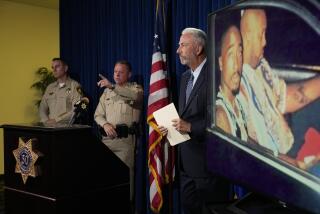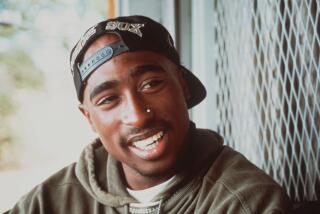Burk case mirrors parts of â86 crime
Charles Samuel, the parolee accused of killing Lily Burk, was convicted 22 years ago of another violent robbery that bore a striking similarity to last monthâs abduction and slaying of the high school senior in downtown Los Angeles, according to court records reviewed by The Times.
As in the Burk case, Samuel was accused of kidnapping someone -- this time an elderly man -- and driving in the manâs car to an ATM, where he demanded that the man withdraw cash.
When no money appeared, Samuel struck the man using the victimâs wooden cane, punched him in the stomach and threatened to kill him if he reported the crime to police, court records show.
Samuel pleaded guilty in June 1987 to robbery, residential burglary and car theft in connection with the attack, which took place in San Bernardino.
During an interview with a probation officer before his sentencing, Samuel gave what appeared to be conflicting accounts about that night, according to a probation report that a judge unsealed Tuesday in response to a request from The Times.
Samuel said he was intoxicated and didnât recall the events of that night but also complained that he âhad not gotten justice,â alleging that the incident involved a dispute over a mutual girlfriend.
At one point Samuel tried to cast doubt on the allegations.
âIf I had beat him like they said, I should have killed him,â he told the probation officer.
In his report to a San Bernardino County judge, the probation officer noted that the December 1986 robbery showed âa high degree of callousnessâ and that Samuel showed no remorse. The judge accepted the probation officerâs recommendation that Samuel be sentenced to six years in prison -- the maximum allowed under his plea agreement.
Los Angeles Police Department investigators, who spoke on condition of anonymity because their probe into Burkâs death is ongoing, said they were unaware of the details from the San Bernardino case but believed the similarities supported their conclusion that Samuel killed the teen.
Burk went missing July 24 while visiting Southwestern Law School in the Mid-Wilshire area as she ran an errand for her mother, a lawyer who teaches at the school.
Police said footage from surveillance cameras shows Samuel driving Burkâs car away from the area of the law school with the 17-year-old in the passenger seat. About 30 minutes later, another camera showed Samuel repeatedly and unsuccessfully trying to withdraw cash at a downtown ATM using a credit card, police said.
Burk made two odd calls to her parents that afternoon, asking how to use a credit card to withdraw cash from an ATM. Her body was found the next morning in her Volvo in a downtown parking lot. Her head had been beaten and her neck slashed.
Samuel, who was out on parole, was supposed to be at a residential drug treatment program when Burk was killed. But he obtained permission from the facilityâs staff to leave for the day.
The randomness of Burkâs death jolted a city long inured to violence and was used by some to attack the stateâs current plans to cut costs by significantly reducing the prison population.
On Tuesday, state officials defended their plan, saying Burkâs death was being misused for political purposes.
Matthew Cate, state corrections secretary, said Samuel had been released on parole under the stateâs current rules and would not have been released any earlier under the proposed rules given his violent criminal record.
Samuel, 50, has been charged with murder, kidnapping and robbery in connection with Burkâs killing. Prosecutors have yet to determine whether they will seek the death penalty. Such a decision is generally made at several months or longer after charges are filed.
Legal experts said Samuelâs earlier robbery conviction could be used against him in the Burk case. The details of the attack, they said, could prove particularly powerful if Samuel is convicted of murder and jurors are asked to decide whether he should be executed.
âIt is a good way for a prosecutor to show that the defendant does his crimes the same way again and again,â said Dmitry Gorin, a former L.A. County prosecutor who now works as a defense attorney.
According to the probation report, James Hollise Johnson was sitting on his front porch about midnight on Dec. 14, 1986.
Johnson, described in the report as elderly, saw Samuel and a companion approach. He did not expect trouble, having seen the two men before in the neighborhood.
But Samuel, a transient who worked as a part-time framer, grabbed Johnsonâs wooden cane and struck him over the head with it. Then he pushed Johnson inside the house.
Johnson gave the two men all the money he could find, about $10. But Samuel and his companion searched the home and found a Bank of America ATM card. Samuel, Johnson and the other man drove in Johnsonâs car to an ATM, where Samuel struck him again.
The probation report described Samuel as a regular user of cocaine. He used marijuana, âwhenever I can afford it.â He had regularly used PCP, quitting during court-supervised drug counseling. He failed to complete a drug diversion program in 1984, the report said.
Samuelâs conviction meant that he would later have two âstrikesâ -- robbery and residential burglary -- on his record after the passage of the 1994 three-strikes law.
But prosecutors said an error on Samuelâs rap sheet led them to believe they could not prosecute him as a third-striker when he was later charged with other felonies. Samuel was convicted of burglary in San Bernardino County in 1997 and of a petty theft in Los Angeles County in 2006.
--
More to Read
Sign up for Essential California
The most important California stories and recommendations in your inbox every morning.
You may occasionally receive promotional content from the Los Angeles Times.












